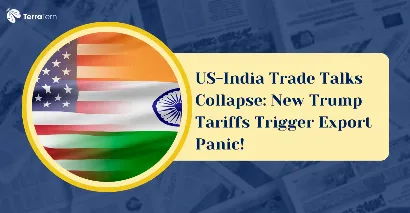Key Highlights
The Indian tariff on Trump is upheaving the global trade. However, in early August 2025, President Donald Trump suddenly doubled tariffs on Indian products, making the total duty 50%, and citing that the US visa policies might yet get stricter towards Indians soon. In this article, we unravel the truth behind what is going on, the implications the same has on Indian exporters and why there is now a raging debate on H-1B visas and India tourist bonds.
Background: Breaking Down the Trade Dispute
Here is the detailed breakdown of the trade dispute:
-
The White House also set an extra 25 per cent tariff on Indian imports beginning August 7, 2025, as India is continuing to buy oil from Russia.
-
This is in addition to a 25 per cent tariff already scheduled to be imposed, which adds up to a staggering 50 per cent of the total.
-
Indian exports that are affected by these tariffs are textiles, jewellery, auto parts and farm products. There are (at the moment) exemptions to electronics and pharma products.
-
It is the high rate that is applied to major trading partners of the US, and therefore India is in the same designation as Brazil.
|
Year |
US Tariff Rate on Indian Goods |
Value of India’s Exports to US (USD Billion) |
|
2024 |
25% |
$86.5 |
|
2025 (Aug) |
50% |
TBD (projected to fall) |
Also Read: U.S. Launches Jobs and Internships Platform for Indians
The Core Issues: Oil, Politics, and What Trump Wants
The government led by Trump has claimed that India did not want to restrain the supply of Russian oil, and its strenuous and obnoxious non-monetary barricades to trade are prime sources of raising the tariff. According to analysts, it is said:
-
India had a surplus of $46B in merchandise trade with the US last year, totalling $212B.
-
The efforts by India to bargain by promising to reduce tariffs on the US industrial goods, but maintain stringent demands for farm products have not yet yielded any results.
How Indian Industries Are Reacting?
The new rates are one of the key threats:
-
The ones at the highest risk include textiles, auto parts, and jewellery because their volumes that go to the US are high and their profit margins are slim.
-
According to analysts, a reduction of trade will result in a 0.6 per cent negative impact on India's GDP.
-
The Indian stock market responded by crashing down in areas that depend heavily on exports, such as clothes and cars.
|
Sector |
Export Value to US (USD Billion) |
Exposure to Tariff (%) |
Potential Job Losses ('000s) |
|
Textiles |
$12.1 |
80 |
275 |
|
Gems & Jewelry |
$9.8 |
65 |
120 |
|
Auto Parts |
$7.2 |
50 |
85 |
|
Agriculture |
$10.5 |
75 |
190 |
Also Read: India Emerges as Second-largest Source Country for New United States Citizens
New Visa Barriers: What’s Changing for Indians?
As attention is focused on trade, the issue of immigration may become the next point of conflict between India and the US. The US visa requirements are becoming harder quickly, and both high-skill workers and tourists are in the crosshairs. 5 of the most important changes in US visa policy in 2025:
-
Visa Interviews: Effective September 2, non-immigrant visa applicants will all (except the H-1B, F-1 and B-1/B-2) require in-person interviews.
-
Integrity Fee: The visa Integrity Fee is a $250 additional fee required by all applicants as of 2026, which increases the overall cost of the visa to $472 (up from $185) for Indians.
-
Visa Bonds: Currently, a pilot program coming into effect August 20 with some tourist/business applicants in countries with high overstay rates, the U.S is issuing a bond of 5000-15000 dollars. It could be included when added to the pilot list of India.
-
Lottery Reform in H-1B: The random lottery is to be changed to a pay level system. The high salaries will present a better opportunity, posing challenges to new graduates and entry-level candidates.
-
Increased Selectivity and Cancellations: There are more than 300 student visas cancelled in the country in 2025. The rejection rates of F-1 applicants are recorded as 41 per cent, and minor violations now result in denials.
|
Policy |
Who Is Affected |
Cost/Barrier |
When Effective |
|
Interview |
All non-immigrant visa applicants |
Extra step |
Sept 2025 |
|
Integrity Fee |
All non-immigrant visas |
$250-500+ |
2026 |
|
Bond |
B-1/B-2, Business, Tourist (select) |
$5,000-$15,000 |
Aug 2025-Mid 2026 |
|
H-1B Rule |
Skilled worker applicants |
Favours high wage |
Proposed |
Also Read: Immigration Relief For Spouses Of US Citizens: Understand Everything
Political Reactions and What It Means Next
The country leading the main opposition is demanding that Modi stand against blackmail, but there is a limited toolbox of countermeasures as compared to China, which has taken more leverage in supplies and rare minerals.
-
The tariffs were deemed as unfair, unjustified, and unreasonable by the government led by Modi, who ensured the protection of India and is currently privately beginning to cut down on Russian oil imports.
-
US Indian relations reached their low in two decades due to the domestic politics of the US as well as gamesmanship around the world.
-
The visa crunch comes at a time when the Indian IT industry is the largest employer in the country with a workforce of millions and providers of half of the American $250B revenue.
-
There is a mood of rising against immigration, and some US lawmakers and advocacy groups now openly call for the outright termination of H-1B visas for Indians, causing an alarm about the broader immigration crackdown.
Conclusion
Trump tariffs on India have pushed an already tense relationship to the brink and may soon be joined by new restrictions on US visas for Indians. For exporters, tech professionals, and students, the road ahead looks uncertain as the world’s two largest democracies stumble through their rockiest patch in decades. For official updates on US tariffs and visa policies, refer to the United States Department of State website. To learn more about US-India trade talks and other important news, visit our official website TerraTern now!








